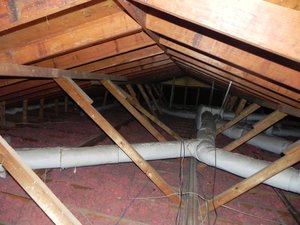Fiberglass insulation material is one of the lowest quality insulation products on the market today. Fiberglass insulation meets minimum code standards and must have a vapor barrier by code. Even though fiberglass is a marginal product, it can function with close to the same efficiency as dense pack cellulose. However, the vapor barrier on the interior walls of the house have to be continuous, and that means lots of tuck tape.
Tuck Tape
Tuck tape is a product that has been around for over 20 years and has typically been used to tape the seems on exterior breathable membranes such as Tyvek, Typar, and other house wraps that allow breathability of a home while preventing air infiltration. As energy standards have become more strict, tuck tape is now required by code on all vapor barrier seems to prevent air movement into the house. Here are a few of the main areas that tuck tape is the most effective.
Electrical Outlets/Switches
Electrical outlets are often culprits of leaking air into a home and have long since been a major contributor to energy loss. Some outlet get so bad in homes, that they form a layer of frost around the outlet plate causing a mildew and mold issue. When the plastic vapor barrier is applied to the walls and the area around the outlet is cut out, tuck tape should be used to attach the plastic to the outlet box creating a continuous vapor barrier. This takes a fair amount of tape, but will help keep the outlets from leaking.
Seams in Vapor Barrier Where the Wall and Ceiling Meet
The seams of the wall vapor barrier and the ceiling vapor barrier should be overlapped at least 6 inches, but air from the attic can still sneak through this seam. It is very important to tape this seam with tuck tape, making sure that the corners and the vapor barrier is tucked tight to the edge of the ceiling so that the tape does not get torn off during the installation of drywall.
Box Sill Insulation
Even though fiberglass insulation should not be used for box sill insulation, it is accepted by minimum code. However, it should have a vapor barrier on it which no one ever performs. Since it is impossible to make this continuous, cut out a piece of vapor barrier and place it over the fiberglass in the box sill. Tape the entire perimeter with tuck tape and then take tuck tape and make an X with it goes from corner to corner. This will act as reinforcement for the vapor barrier. This method will prevent condensation from moving into the house and causing mold and mildew problems.
Vapor barriers are an important part of insulation projects and should be taken very seriously in their installation, especially when dealing with materials like fiberglass batt insulation. If you are going to use spray foam insulation, closed cell acts as it’s own vapor barrier and does not need any extras. Open cell spray foam requires a vapor barrier paint that is .3 mil thick to maintain the correct perm rating.



